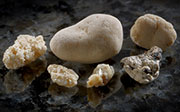- Navigating Your Midlife Crisis: Embracing New Possibilities
- City Raccoons Showing Signs of Domestication
- Mapping the Exposome: Science Broadens Focus to Environmental Disease Triggers
- One Week Less on Social Media Linked to Better Mental Health
- Your Brain Changes in Stages as You Age, Study Finds
- Some Suicide Victims Show No Typical Warning Signs, Study Finds
- ByHeart Formula Faces Lawsuits After Babies Sickened With Botulism
- Switch to Vegan Diet Could Cut Your Greenhouse Gas Emissions in Half
- Regular Bedtime Does Wonders for Blood Pressure
- Dining Alone Could Mean Worse Nutrition for Seniors
Will Kidney Stones Recur? New Test Might Tell


A new tool appears to accurately predict whether someone who’s had a kidney stone will have another one in the future, researchers report.
They said the tool could help patients and their doctors decide whether preventive steps are needed.
The tool uses 11 questions to assess kidney stone patients’ risk of developing another kidney stone within two, five or 10 years. Characteristics associated with a higher risk include: being younger, male and white; a family history of kidney stones; blood in the urine; a kidney stone made of uric acid; having an obstructing stone in the kidney pelvis, or additional non-obstructing stones; and a past history of kidney stone-related pain from a stone that was not actually seen.
The tool was developed using data from more than 2,200 adults in Olmsted County, Minn., who experienced their first symptomatic kidney stone between 1984 and 2003. More than 700 of those people had another kidney stone by 2012.
The questionnaire, described in an article published Aug. 7 in the Journal of the American Society of Nephrology, was created by Dr. Andrew Rule, of the Mayo Clinic, and colleagues.
Kidney stones are solid pieces of material that form in a kidney because of certain substances in urine. Small stones cause little discomfort, but larger ones can get stuck in the urinary tract and cause much pain.
Nine percent of men and 6 percent of women in the United States have had a painful kidney stone. Medications and dietary changes can help prevent another kidney stone, but these preventive measures can be costly, difficult or cause side effects.
“If we knew which patients were at high risk for another symptomatic kidney stone, then we could better advise patients on whether to follow stone prevention diets or take medications,” Rule said in a journal news release.
“At the same time, patients who are at low risk of having another kidney stone may not need restrictive diets and medications,” he added.
More information
The U.S. National Library of Medicine has more about kidney stones.
Source: HealthDay
Copyright © 2025 HealthDay. All rights reserved.










